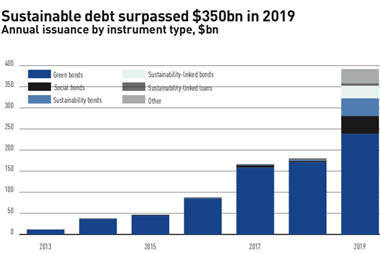The Asian Infrastructure Investment Bank (AIIB) and Amundi have launched a climate change investment framework that they say is pioneering because it seeks to “holistically assess climate change risks and opportunities in line with the three objectives of the Paris Agreement at the issuer-level”.
They said the framework translated these objectives into fundamental investment metrics, “equipping investors with a new tool to assess an issuer’s level of alignment with climate change mitigation, adaptation, and low-carbon transition objectives”.
According to the two organisations, current efforts to mobilise private capital to respond to climate change lacked such a holistic approach.
Equity capital markets currently focussed on thematic funds and commonly faced strong sector bias, they said, while low-carbon indexes had a pronounced focus on mitigation efforts and, in fixed income, green bonds did not consider exposure to climate investment risks and opportunities from the viewpoint of an issuer’s entire balance sheet.
A spokesperson for Amundi explained that the ambition for the framework is that it sets the benchmark for climate investing strategies looking to align themselves with the Paris Agreement, adding that the initiative would be continuously evolving.
AIIB president Jin Liqun said: “In launching this framework today, we and our partners show our commitment to playing an important role in the battle against climate change, by contributing to strengthening market capacity and driving the green agenda in Asia.”
A $500m (€417m) Asia Climate Bond Portfolio that the AIIB launched last year is to serve as a working model and investment case for the new framework, application of which is intended to reach all types of issuers and sectors of an economy.
Encourage emergence of A-listers
According to the AIIB and Amundi, by implementing the framework, investors could engage with so-called “B-list” issuers to boost their climate change-related credentials to “A-list” status.
In a working paper, they said the cumulative number of B-list issuers engaged to enter the A-list stood as the main proxy for measuring the framework’s success and annual impact, while additional impact indicators depended on the financial instruments in a strategy’s investment universe.
“The philosophy is to encourage the emergence of climate champions by highlighting the business model of top performers”
Yves Perrier, CEO, Amundi
Speaking during a Climate Bonds Initiative (CBI) virtual conference this morning, Yves Perrier, CEO of Amundi, said the point of the new framework was not to “point fingers” at certain issuers or sectors, but that its philosophy was “to encourage the emergence of climate champions by highlighting the business model of top performers”.
One of the benefits of the framework, according to AIIB and Amundi, is that it would enable investors from developed markets to channel capital towards emerging markets, “where the challenge of a low-carbon, climate resilient transition is greatest”.
Aside from the framework’s “extra-financial impact”, AIIB and Amundi said investors could expect portfolios aligned with it to potentially benefit from future repricing of climate change risk in capital markets in the long-term.
“An investment strategy targeting both A and B list issuers should be more resilient to climate change risk and more exposed to opportunities not yet priced in by the market,” they said.
Sean Kidney, CEO at the CBI, which has endorsed the AIIB and Amundi framework, said: “Action on climate means action on investment and private sector involvement to create green capital markets. With this framework, AIIB and Amundi are laying a new foundation for the development and growth of climate finance and transition investment in the region.”
CBI, CS transition bond framework
The launch of the AIIB-Amundi framework comes a day after the CBI and Credit Suisse launched a white paper presenting a framework for identifying credible Paris-aligned transition pathways for companies.
The aim is to support the rapid growth of a market for transition bonds, an emerging concept and label for bonds that do not meet green bond market standards but are issued by qualifying companies in high emitting sectors whose evolution is seek as key to delivering on the goals of the Paris Agreement.
The idea behind establishing a framework, as proposed by CBI and Credit Suisse, is to give investors confidence that transactions labelled as transition transactions are credible – not greenwash.
Asked about the relationship between the CBI and Credit Suisse whitepaper and the Amundi and AIIB framework, the Amundi spokesperson told IPE both initiatives had the same motivation, in that every corner of the economy had to undergo a low carbon transition for the Paris Agreement goals to be met.
The spokesperson added: “As with green bonds, such transition bonds are an interesting way for issuers to signal to investors that they are starting to replace carbon intensive activities with more efficient activities on their balance sheet.
“From the point of [our] framework, there is the question of what we would consider as an allowable intermittent technology but this would also need to be coupled with strict issuer level commitments to using such intermittent technologies only temporarily to help their low-carbon transition.
“On top of that, the issuer must be making strides in adaptation and resilience to climate change.”
“We see transition bonds as being a significant game changer in terms of broadening the universe of issuers who can begin to transition towards sustainability.”
Marisa Drew, chief sustainability officer and global head of sustainability strategy, finance and advisory at Credit Suisse
In their paper, CBI and Credit Suisse set out five principles for an ambitious transition, according to which all goals and pathways would need to:
- Align with zero carbon by 2050 and nearly halving emissions by 2030;
- Be led by scientific experts and not be entity- or country-specific;
- Be sure that credible transition goals and pathways don’t count offsets;
- Include an assessment of current and expected technologies which can be used to determine a decarbonization pathway;
- Be backed by operating metrics rather than a commitment or pledge.
Marisa Drew, chief sustainability officer and global head of sustainability strategy, finance and advisory at Credit Suisse, said: “While much of the focus on the capital markets has rightly been on green and sustainability bonds, we see transition bonds as being a significant game changer in terms of broadening the universe of issuers who can begin to transition towards sustainability.
”This paper represents an important milestone in the development of the sustainable finance markets and one which helps us all transition to a low-carbon economy.”










No comments yet